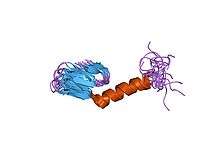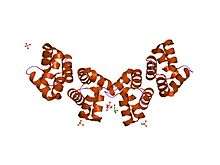Class II bacteriocin
Class II bacteriocins are a class of small peptides that inhibit the growth of various bacteria.
| Class II bacteriocin | |||||||||
|---|---|---|---|---|---|---|---|---|---|
 Three-dimensional structure of leucocin A, a type IIa bacteriocin.[1] | |||||||||
| Identifiers | |||||||||
| Symbol | Bacteriocin_II | ||||||||
| Pfam | PF01721 | ||||||||
| InterPro | IPR002633 | ||||||||
| PROSITE | PDOC60030 | ||||||||
| SCOPe | 3leu / SUPFAM | ||||||||
| TCDB | 1.C.24 | ||||||||
| OPM superfamily | 141 | ||||||||
| OPM protein | 1ohm | ||||||||
| |||||||||
Many Gram-positive bacteria produce ribosomally synthesized antimicrobial peptides, termed bacteriocins.
Bacteriocins for which disulfide bonds are the only modification to the peptide are Class II bacteriocins.
Class IIa
One important and well studied class of bacteriocins is the class IIa or pediocin-like bacteriocins produced by lactic acid bacteria. All class IIa bacteriocins are produced by food-associated strains, isolated from a variety of food products of industrial and natural origins, including meat products, dairy products and vegetables. Class IIa bacteriocins are all cationic, display anti-Listeria activity, and kill target cells by permeabilizing the cell membrane.[2][3][4]
Class IIa bacteriocins contain between 37 and 48 residues.[5] Based on their primary structures, the peptide chains of class IIa bacteriocins may be divided roughly into two regions: a hydrophilic, cationic and highly conserved N-terminal region, and a less conserved hydrophobic/amphiphilic C-terminal region. The N-terminal region contains the conserved Y-G-N-G-V/L 'pediocin box' motif and two conserved cysteine residues joined by a disulfide bridge. It forms a three-stranded antiparallel beta-sheet supported by the conserved disulfide bridge. This cationic N-terminal beta-sheet domain mediates binding of the class IIa bacteriocin to the target cell membrane. The C-terminal region forms a hairpin-like domain that penetrates into the hydrophobic part of the target cell membrane, thereby mediating leakage through the membrane. The two domains are joined by a hinge, which enables movement of the domains relative to each other.[3][4]
Some proteins known to belong to the class IIa bacteriocin family are listed below:
- Pediococcus acidilactici pediocin PA-1.
- Leuconostoc mesenteroides mesentericin Y105.
- Carnobacterium piscicola carnobacteriocin B2.
- Lactobacillus sakei sakacin P.
- Enterococcus faecium enterocin A.
- Enterococcus faecium enterocin P.
- Leuconostoc gelidum leucocin A.
- Lactobacillus curvatus curvacin A.
- Listeria innocua listeriocin 743A.
Class IIb
| Class IIb bacteriocin | |||||||||
|---|---|---|---|---|---|---|---|---|---|
| Identifiers | |||||||||
| Symbol | Antimicrobial17 | ||||||||
| Pfam | PF08129 | ||||||||
| Pfam clan | CL0400 | ||||||||
| InterPro | IPR012950 | ||||||||
| TCDB | 1.C.25 | ||||||||
| OPM superfamily | 219 | ||||||||
| OPM protein | 2jpj | ||||||||
| |||||||||
The class IIb bacteriocins (two-peptide bacteriocins) require two different peptides for activity. It includes the alpha enterocins and lactococcin G peptides. These peptides have some antimicrobial properties; they inhibit the growth of Enterococcus spp. and a few other Gram-positive bacteria. These peptides act as pore-forming toxins that create cell membrane channels through a barrel-stave mechanism and thus produce an ionic imbalance in the cell[6]
Class IIc
| Bacteriocin_IIc | |||||||||
|---|---|---|---|---|---|---|---|---|---|
 x-ray structure of bacteriocin as-48 at ph 4.5. sulphate bound form | |||||||||
| Identifiers | |||||||||
| Symbol | Bacteriocin_IIc | ||||||||
| Pfam | PF09221 | ||||||||
| InterPro | IPR009086 | ||||||||
| SCOPe | 1o82 / SUPFAM | ||||||||
| TCDB | 1.C.28 | ||||||||
| OPM superfamily | 77 | ||||||||
| OPM protein | 1o82 | ||||||||
| |||||||||
Other class II bacteriocins can be grouped together as Class IIc (circular bacteriocins). These have a wide range of effects on membrane permeability, cell wall formation and pheromone actions of target cells. In particular, Bacteriocin AS-48 is a cyclic peptide antibiotic produced by the eubacteria Enterococcus faecalis (Streptococcus faecalis) that shows a broad antimicrobial spectrum against both Gram-positive and Gram-negative bacteria. Bacteriocin AS-48 is encoded by the pheromone-responsive plasmid pMB2, and acts on the plasma membrane in which it opens pores leading to ion leakage and cell death.[7] The globular structure of bacteriocin AS-48 consists of five alpha helices enclosing a hydrophobic core. The mammalian NK-lysin effector protein of T and natural killer cells has a similar structure, though it lacks sequence homology with bacteriocins AS-48.
References
- Fregeau Gallagher NL, Sailer M, Niemczura WP, Nakashima TT, Stiles ME, Vederas JC (December 1997). "Three-dimensional structure of leucocin A in trifluoroethanol and dodecylphosphocholine micelles: spatial location of residues critical for biological activity in type IIa bacteriocins from lactic acid bacteria". Biochemistry. 36 (49): 15062–72. doi:10.1021/bi971263h. PMID 9398233.
- Ennahar S, Sonomoto K, Ishizaki A (1999). "Class IIa bacteriocins from lactic acid bacteria: antibacterial activity and food preservation". J. Biosci. Bioeng. 87 (6): 705–16. doi:10.1016/S1389-1723(99)80142-X. PMID 16232543.
- Fimland G, Nissen-Meyer J, Johnsen L (2005). "The C-terminal domain of pediocin-like antimicrobial peptides (class IIa bacteriocins) is involved in specific recognition of the C-terminal part of cognate immunity proteins and in determining the antimicrobial spectrum". J. Biol. Chem. 280 (10): 9243–50. doi:10.1074/jbc.M412712200. PMID 15611086.
- Dalhus B, Fimland G, Nissen-Meyer J, Johnsen L (2005). "Pediocin-like antimicrobial peptides (class IIa bacteriocins) and their immunity proteins: biosynthesis, structure, and mode of action". J. Pept. Sci. 11 (11): 688–96. doi:10.1002/psc.699. PMID 16059970.
- Simon L, Fremaux C, Cenatiempo Y, Berjeaud JM (2002). "Sakacin g, a new type of antilisterial bacteriocin". Appl. Environ. Microbiol. 68 (12): 6416–20. doi:10.1128/AEM.68.12.6416-6420.2002. PMC 134399. PMID 12450870.
- Balla E, Dicks LM, Du Toit M, Van Der Merwe MJ, Holzapfel WH (April 2000). "Characterization and cloning of the genes encoding enterocin 1071A and enterocin 1071B, two antimicrobial peptides produced by Enterococcus faecalis BFE 1071". Appl. Environ. Microbiol. 66 (4): 1298–304. doi:10.1128/aem.66.4.1298-1304.2000. PMC 91984. PMID 10742203.
- González C, Langdon GM, Bruix M, Gálvez A, Valdivia E, Maqueda M, Rico M (October 2000). "Bacteriocin AS-48, a microbial cyclic polypeptide structurally and functionally related to mammalian NK-lysin". Proc. Natl. Acad. Sci. U.S.A. 97 (21): 11221–6. doi:10.1073/pnas.210301097. PMC 17181. PMID 11005847.
Further reading
- Papathanasopoulos, M. A.; Dykes, G. A.; Revol-Junelles, A. M.; Delfour, A.; Von Holy, A.; Hastings, J. W. (1998). "Sequence and structural relationships of leucocins A-, B- and C-TA33a from Leuconostoc mesenteroides TA33a". Microbiology. 144 (5): 1343–1348. doi:10.1099/00221287-144-5-1343. PMID 9611809.
- Fregeau Gallagher, N. L.; Sailer, M.; Niemczura, W. P.; Nakashima, T. T.; Stiles, M. E.; Vederas, J. C. (1997). "Three-Dimensional Structure of Leucocin a in Trifluoroethanol and Dodecylphosphocholine Micelles: Spatial Location of Residues Critical for Biological Activity in Type IIa Bacteriocins from Lactic Acid Bacteria†,‡". Biochemistry. 36 (49): 15062–15072. doi:10.1021/bi971263h. PMID 9398233.
External Links
Class II bacteriocin and related families is variously recorded in Pfam and InterPro as:
| Pfam | Pfam symbol | InterPro | InterPro symbol |
|---|---|---|---|
| PF08129 | Antimicrobial17 | InterPro: IPR012950 | Alpha_enterocin/lactococcin |
| PF01721 | Bacteriocin_II | InterPro: IPR002633 | Bacteriocin_IIa |
| PF10439 | Bacteriocin_IIc | InterPro: IPR019493 | Bacteriocin_IIb_lactacin-rel |
| PF12173 | BacteriocIIc_cy | InterPro: IPR020970 | Bacteriocin_IIc |
| PF04369 | Lactococcin | InterPro: IPR007464 | Bacteriocin_IId |
| PF04604 | L_biotic_typeA | InterPro: IPR007682 | Lantibiotic_typ-A_Lactobact |
The naming is inconsistent at times.